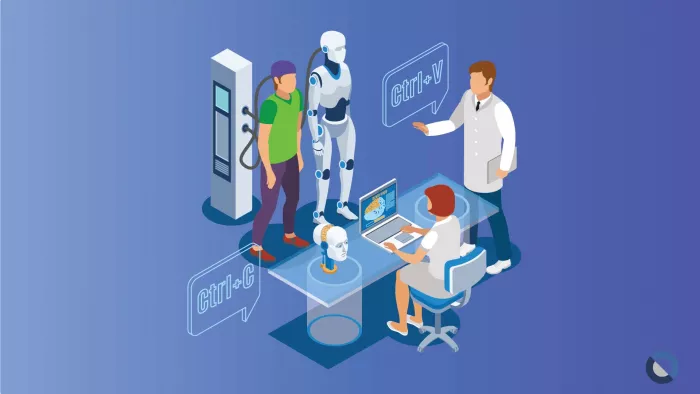Simulation-based training is becoming increasingly popular for transforming the corporate Learning and Development (L&D) landscape with practical training experiences. From healthcare and education to manufacturing and aviation, employees from all walks of life can improve their technical skills, problem-solving abilities, critical thinking, and decision-making through this powerful training tool. Keep reading to understand why it’s a game-changer for training and development.
What Is Simulation-Based Training?
Simulation training is a dynamic method that creates immersive replications of real-life work scenarios for employees to improve their skills and knowledge in a controlled setting. Simulating scenarios related to a specific job role or industry allows employees to apply their theoretical knowledge to practical situations, so they can learn by practicing. Simulation training goes beyond traditional methods and creates a risk-free environment for critical thinking and problem-solving through virtual and physical models.
Virtual simulations use computer-based technologies to create lifelike, interactive scenarios so employees can engage with and respond to the problem as they would in real life. On the other hand, physical simulations use physical replicas to simulate real-world situations. Whether using mannequins for simulated medical procedures or flight simulators replicating the in-flight circumstances for training pilots, physical simulations allow trainees to gain hands-on work experience and bridge the gap between theory and practice.

Simulation-Based Training: Key Essentials & Types
Traditional training methods heavily depend on case studies, lectures, and training programs, while simulation training uses technology to create virtual scenarios replicating complicated business issues. As a trainee, you are required to employ strategic thinking, clear communication, and team collaboration, as in realistic situations, and actively engage in finding the solution.
Most importantly, the training experience goes beyond the traditional role-play exercises. You will continuously find yourself in dynamically evolving scenarios where you’ll get first-hand experience with decision-making procedures and receive individualized, real-time feedback on how practical your approach is. Let’s review the primary types of simulation training and their unique components.
Game-Based Simulations
As the name suggests, these simulations use gaming elements to facilitate learning and foster critical thinking, teamwork, and problem-solving skills. They incorporate engaging gaming elements like challenge levels, rewards, and progression for immersive learning and provide instant feedback to keep users engaged and motivated.
In-Person Simulations
These simulations replicate specific facilities, such as mock emergency centers, hospital wards, and manufacturing plants. Users can engage in hands-on experience of particular tasks in a high-level, realistic environment to hone critical skills and the ability to tackle complicated problems.
Interactive Web-Based Simulations
Users can engage with real-life-like scenarios through online platforms, make decisions, and receive immediate feedback. From quizzes to multimedia content and branching situations, these simulations increase learner engagement and knowledge retention while ensuring cost-effectiveness, accessibility, and scalability.
3D Simulations
Augmented, virtual, and mixed-reality simulations use advanced technologies to create immersive training environments. While augmented reality overlays digital information, virtual reality creates a virtual world, and mixed reality combines the virtual elements with the real world. Through these simulations, users can engage in hands-on tasks, interact with 3D objects, and navigate real-world-like scenarios to develop the ability to stimulate complex situations.
Why Should Businesses Use Simulation Training?
The global simulation training market is expected to reach 52.91 billion from 15.72 billion by 2033. More and more businesses are adopting the simulation training model for three primary factors:
- Realism: Offers a genuine, immersive environment with high-fidelity simulations closely replicating realistic settings
- Interactivity: Allows users to engage with the simulation, make decisions, and monitor results in real time
- Feedback Mechanisms: Provides prompt feedback to ensure the quick resolution of the error and promote detailed understanding of the concepts.
Simulation training has a multitude of benefits across industries, making it a valuable investment.
Immersive Learning And Competency Enhancement
Simulation training creates a realistic and targeted practical learning experience by mirroring real-world situations. You can apply your knowledge and practical skills to overcome work-related challenges and improve learning retention.
Safe Learning Environment
Some on-the-job mistakes can be costly and life-threatening, especially in the healthcare and aviation industries. Training simulation creates a controlled environment for learning, exploring, and experimenting with different strategies without hazardous consequences.
Adaptability And Scalability
These training simulators are adaptable to changing business needs, industry guidelines, and technological upgrades. They quickly update the modules to accommodate the training needs per the advancements without additional costs.
Standardization And Resource Efficiency
Implementing simulation practices ensures a standard training model for all employees to maintain quality and consistency. Furthermore, it reduces the need for expensive training resources and equipment and saves time as employees can access simulations at their convenience without affecting daily operations.
Teamwork And Employee Engagement
Several simulation training programs involve team-based situations to improve collaboration, strengthen team dynamics, and foster a sense of unity among the team members through gamified elements. From receiving instant feedback to measurable progress, simulation training ensures higher engagement and maximized outcomes.
How To Implement a Simulation Training Model?
While training solutions vary by organization and industry, there are a few common steps to follow.
- Identify the specific training objectives and define goals based on them for designing effective training strategies.
- Identify the employee or group of employees who will engage with the training program.
- Before designing the learning paths, perform formal assessments to identify skill gaps.
- Choose proper simulation methods, from conversational simulations to lab environments, roleplaying, or computer-based simulations.
- Invest in the next-gen L&D tools and employee training software to make simulated training more realistic and practical.
- Build real-life-like scenarios with clear narratives to improve retention and promote quick information retrieval.
- Design interactive learning experiences that are easy to digest. Include progress checkpoints and offer immediate feedback to motivate them to improve and make the most of their learning experience.
- Include a real-time monitoring feature to track employees’ progress and determine the effectiveness of the L&D programs. With compiled reports from employee feedback, data analytics tools, and progress assessments, the L&D teams can adjust and upgrade training programs to achieve the training goals.
To conclude, combining training and simulation can create new learning opportunities and give companies the tools to help their employees upgrade their on-the-job skills, critical thinking, problem-solving, teamwork, communication, and decision-making abilities. Through simulations, trainers can create a secure and regulated environment for employees to hone their skills and abilities to handle real-world challenges confidently. Therefore, companies should invest in simulation training to keep up with the competition and meet organizational goals.
Post Comment
Be the first to post comment!





